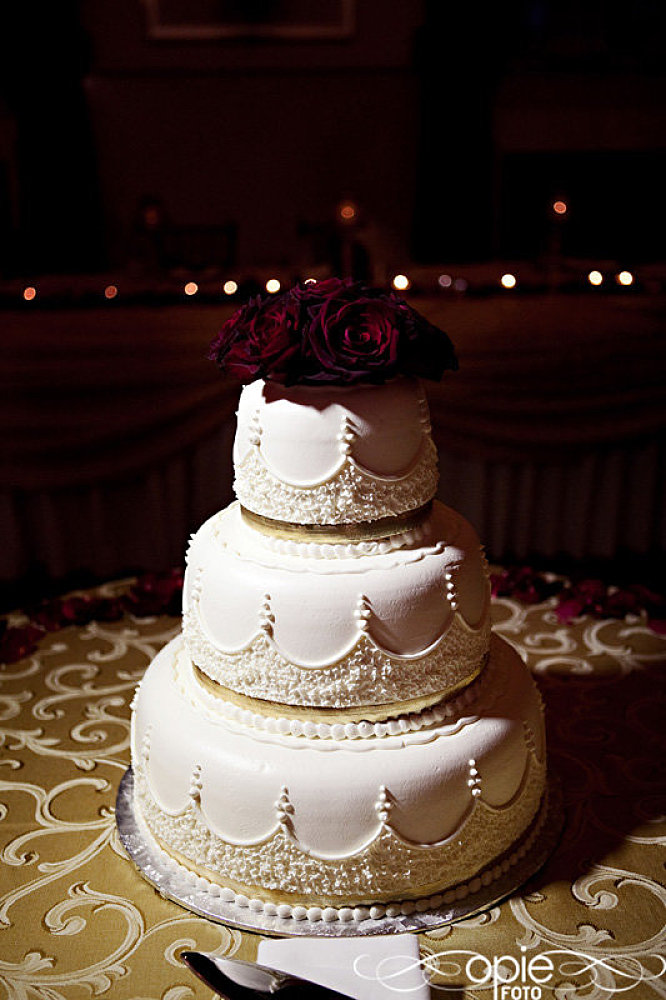The History and The Tradition Of Wedding Cake.
March 6th, 2014
Marriage is one of those events that are full of so many beliefs and traditions that it takes on an almost magical air even without the fancy trappings of a royal wedding. Some traditions are unique to each couple, such as being married at the same location that parents or siblings were married at. Others are long-standing traditions that make a wedding a wedding, such as the tradition of wedding cake.
Origins
The modern wedding cake has an interesting tale to tell. In ancient Rome it was customary to break a piece of bread over the bride's head to ensure good fortune to the couple. Bread has long been connected to prosperity and good fortune in many cultures.
In France, a tradition is the "croquembouche", which is a tower of bread rolls. The tradition was that if the bride and groom could kiss each other over the top of the tower without knocking it over, then it meant good luck for the marriage.
The modern wedding cake, with it's multi-tiered shape owes the concept pf the tower to the croquembouche, but its cathedral-like appearance owes itself to, well, a cathedral! Appropriately enough, it was inspired by St. Bride's Church in London, England. As the story goes, in 1703 a baker's apprentice from Ludgate Hill named Thomas Rich fell in love with his boss's daughter. He wanted to make the best, most extravagant cake he could, so he recreated the church as best he could in cake.
Rings, Flowers, and Grooms
It used to be tradition for the bride to hide a glass ring inside the cake somewhere. Whoever found the ring would be the next to be married. One can imagine how many people may have accidentally bitten down on the glass ring! Fortunately, these days we just throw a flower bouquet.
Early wedding cakes as we know them today were called "bride cakes", and were traditionally a plum or fruit cake. Fruit was a symbol of fertility which helped the fruit cake gain in popularity as large families were the desired thing. Along with the bride cake, there used to be a "groom cake", which was traditionally smaller and darker. Though popular in the 17th century, the practice of serving the two cakes has faded, though it is still fairly common in the American south.
Cake-toppers usually represent the bride and groom, in essence combining the idea of both cakes in the form of a little figure on top. Some cake toppers reflect hobbies or other themes. The varieties available are endless.
Symbols
Wedding cakes, as bride cakes have come to be known, are no longer normally a fruit cake. They are now most likely to be a pound cake iced in white to symbolize purity. Other symbols of purity still found on wedding cakes are calla lilies.
Where groom cakes are still used, they often reflect the groom's profession or hobbies. This, however, is slowly becoming popular for couples. One couple who liked to travel a lot had a tiered cake made up to look like a stack of suitcases!
Cutting the cake is another symbolic aspect of the wedding cake. Early traditions had the bride cut and serve the cake herself. As wedding cakes became larger and heavier, the groom began to help the bride cut and serve the cake. This evolved into the symbolic cutting of the first piece together to symbolize their union and willingness to provide for each other.
While some couples enjoy the playfulness of smashing the cake into each others' faces, you may breathe a sigh of relief if you are more traditional in your approach. The commonly held belief is that some couples would feed each other the first bite of cake and sometimes the icing would get a little messy. The idea of smashing it to "get it over with" is a contemporary practice borne out of a joke and is not required. Yes, ladies, you needn't fret about your hair, your make-up, or your dress getting slathered in wedding cake if you don't want to!
Superstitions
In Victorian times, some couples kept the cake intact until their first anniversary in the belief that it prevented problems from arising in the marriage. Since these cakes were fruit cakes made with wine, they often stayed quite well preserved.
Bridesmaids would take crumbs of the wedding cake home and pass them through a ring in the hopes of dreaming of their future husbands. Some also went the extra step of putting some of the cake in their left stockings overnight to improve the chances of having such a dream.
An American tradition is to hide a token or a ring inside of one of a group of ribbons around the base of the cake. Whoever finds the token will be the next to marry.
Also an American tradition, some guests will eat the crumbs of the cake, leaving nothing on the plate or serving tray, in the hopes that it will bring the same good fortune to them as it is supposed to for the newlyweds!
A wedding cake is not only a work of art and a decoration at a reception. It is a tradition that goes back hundreds and hundreds of years. Deeply symbolic, yet customizable for the couple, it's the ultimate must-have for your wedding (aside from an actual couple to be married!). And if you should honor some of the traditions and superstitions and someone calls it an "old wives' tale", remind them that an old wife is what you are attempting to become!


